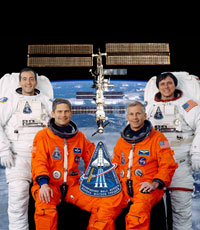


Listen to audio highlights from this interview. 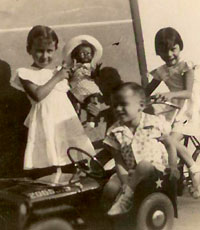
Franklin Chang-Díaz (shown here with his sisters) grew up in Costa Rica, but he realized at an early age that he would someday move to the United States to try to become an astronaut. 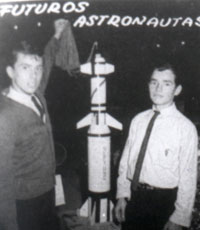
As a student, Chang-Díaz (left) created a model rocket that took an intrepid mouse astronaut into the sky and brought him safely back down again. 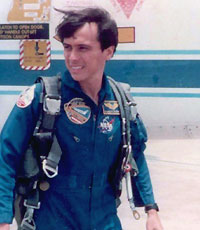
Once he was selected as a member of the astronaut corps, he knew he would make it into space, says Chang-Díaz. 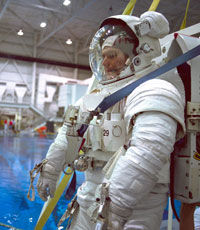
Astronauts train in the pool at the Natural Buoyancy Laboratory to learn how to maneuver in space. In this photo, Chang-Díaz trains for the STS-91 mission. 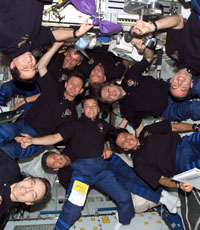
The International Space Station has been serviced by an increasingly diverse community of crew members over the years, says Chang-Díaz (bottom right). |
In the late 1960s, a teenaged Franklin Chang-Díaz, speaking not a word of English, left his home country of Costa Rica and headed to the United States with the improbable dream of becoming an astronaut. In 1986, after earning a Ph.D. in plasma physics from MIT, Chang-Díaz took to the stars for the first time aboard the Space Shuttle Columbia. He returned to space six more times, setting a record for the most spaceflights, and also helped change the culture at NASA by showing that scientists—not just fighter pilots—had the right stuff to serve as astronauts. In this interview, get a sense of what enabled Chang-Díaz to realize his dream, and glimpse his equally ambitious hopes for the future of space travel. CHILDHOOD FANTASIESNOVA: What are your earliest memories of being interested in space travel? Franklin Chang-Díaz: I was captivated by Sputnik as a child. I felt that, someday, humans would travel to distant planets, and I decided that I wanted to be one of those travelers—I would be a space explorer. When I was young, I spent afternoons imagining that I had my own rocket ship. I would invite my cousins and my friends to join my crew, and we would lie on our backs inside a very large cardboard box and go through a countdown, blast off into space, spend the whole day exploring other planets, and be back in time for dinner. So that was sort of the beginning—my earliest memories of being fascinated by space. Q: How did you plan to go about becoming a space explorer? Chang-Díaz: I come from a family of immigrants—my grandparents and parents immigrated to and from Costa Rica from their own countries. My paternal grandfather immigrated to Costa Rica from China, my maternal grandfather was from Costa Rica, but lived and worked in the USA for much of his life. My father and mother immigrated to Venezuela where they lived for many years, and I always knew that at some point I would leave Costa Rica and go, most likely, to the United States to become an astronaut, or at least try to do so. My family never prevented me from doing that, but they couldn't really help me. We were not a well-to-do family. Even though my parents put us in the best, most expensive schools, and we got a first-rate education, my parents were not rich. Neither one of them finished college. So I was expected to make my own way as soon as I finished high school. I couldn't expect to receive a college education on my father's dime. But I was expected to have a college education. I was expected to reach very high. Q: Why did you decide to come to the U.S.? Chang-Díaz: I decided that if I wanted to be a scientist—and I wanted to be an astronaut—if I wanted to be an astronaut and a scientist, I would have to go to the United States. My grandfather had always encouraged me to go to the United States, so that is where I went. Q: What did you do when you arrived here? Chang-Díaz: I moved to Hartford, Connecticut and enrolled in public high school. I had already finished high school in Costa Rica, but I didn't speak English, so I started over again. I was learning the language by sheer, total immersion. I had no choice. Alan Winter, one of the teachers of the high school, took notice of me and became interested in helping me. He coached me in English and helped me prepare for university. At the end of the school year, I was given a scholarship to attend the University of Connecticut as a full-time engineering student with a four-year scholarship. But when I got to the university, they said they'd made a mistake. "You have very good grades," they told me. "You deserve this scholarship, but you are not a U.S. citizen. We thought that you were from Puerto Rico, not from Costa Rica." Well, that was a bucket of cold water. I went back to the high school and related this story to the teachers, who apparently wrote a petition. The Connecticut legislature met and decided to offer me one year of the scholarship, and let me pay the lower, in-state tuition, because they had already offered the scholarship. So I took loans and worked in the university physics department to finance the other three years. This, to me, is America. This is what America is all about—the ability to get ahead by hard work. So I was able to attend the university and finish my education, and then I was on my way to becoming a scientist and an astronaut. Q: Did you ever think you wouldn't make it? Chang-Díaz: For a boy who doesn't speak English, coming from a country like Costa Rica, to set his sights on going to the United States to become an astronaut, the odds are extremely long. I don't think anyone in my family, or even my friends, ever really believed that this was a possibility for me, and I really wasn't expecting anybody to believe in my dream. The chances of becoming an astronaut were very low. But it was never impossible. Right after the [1969] moon landing, when Neil Armstrong first set foot on the moon, I got discouraged. One of my professors, an aerospace engineer at the University of Connecticut, said, "Don't become an aerospace engineer." NASA [eventually] canceled the Apollo program, and there were thousands of aerospace engineers out of work, some of them driving taxicabs or riding elevators or pumping gas. "Do something else," my professor [had] said. "The space program is not the right place." That was a sobering thought, and it was enough—because this was a teacher that I respected—to steer me a little bit, but not completely, off track. ONE SMALL STEP CLOSER TO SPACEQ: What did you do then? Chang-Díaz: I decided to move into the area of energy and nuclear power, and eventually nuclear fusion. I figured that the space program was bound to come back, and I knew that nuclear power would be needed for travel to Mars and planets beyond. I didn't feel like I'd given up on my dream. I was just getting a little insurance, in case I couldn't become an astronaut after all. I spent most of my years in graduate school at MIT concentrating on the problem of controlled thermonuclear fusion, and I almost forgot about space until 1977, when the space shuttle first flew. All of a sudden, the space program came alive again, and NASA issued a request for another group of astronauts. So I threw my hat in the ring and, well, I was selected. Q: How did you react to learning that you were picked to be an astronaut? Chang-Díaz: After I got that call, I went running out the door and across the street—I almost got run over by a cab. I was in a different world all of a sudden. My life changed completely from that day on. Q: Once you were selected, did you face other challenges at NASA? Chang-Díaz: Young people often ask me if I'm a scientist or an astronaut, and I say that I'm both. But in the early days of spaceflight, people tended to be one or the other. The astronauts were military men, and the rocket scientists designed the rockets, but they never got to fly. That division was an obstacle for me at NASA. When I first started, it was clear that being a scientist made you less likely to fly. But that didn't seem right to me, and I kept working to remain both a scientist and an astronaut. In the end, I won out. I remained a scientist, and I flew more than anybody else. Throughout my years in the astronaut corps, I think I helped bridge that gap. Obviously, both parts of the personality are important—having military discipline is just as important as having an inquisitive mind, a formally trained, scientific mind. What I've done to prove that those qualities can fit together in one person is one of the most satisfying accomplishments in my 25 years in the space program. BEING AN ASTRONAUTQ: What do you do right before you go into space? What's the routine? Chang-Díaz: Before we fly, there is a period of quarantine, where we're isolated from everyone except our spouses. But even though you can't see your family, they're all there—all of your friends, all of your family, and thousands of other people who come to see the launch. On the day of launch, you have breakfast—if you can, because everyone gets nervous even if they don't admit it. Then you get suited up. You say goodbye to people you really love, and you're taken to the rocket. Everything you do that morning is predetermined. You let the technicians hook everything up—hundreds and hundreds of connections and wires. The flurry of activity and communication makes you feel sort of nice, because you're in good company, with people who seem to know what they're doing. And then, all of a sudden, everybody leaves, and the place becomes quiet. You wonder, "Where did everybody go?" They're five miles away. Slowly, it dawns on you that they're about to light up this big rocket, and you're sitting on top of it, and it has to work. Q: Were you concerned about the risks associated with spaceflight? Chang-Díaz: I think that it's much more difficult for the family on the ground than for the astronaut who is flying. If we die, we are dying doing that which we love the most to do. But the people on the ground are left with nothing. They're just there, watching. When my wife and I would part, just before every flight, there was a lot unsaid. We knew it couldn't be said, because it would be too difficult to utter those words. It was clear that we were saying goodbye, and it was clear that we—at least I—faced danger, and that maybe I wouldn't come back. Q: You've seen colleagues die in launches and reentry. In fact, for a short time you were scheduled to fly on the ill-fated 1986 Challenger mission. How did that disaster impact you? Chang-Díaz: When the Challenger flight took place, we had just returned from a mission. The crew all came to the viewing room at the Johnson Space Center to watch our friends go fly in space. I think that we were [pauses] all unprepared to deal with this kind of event. From my first flight, before the Challenger disaster, to my second flight, after, it felt as if we had lost our innocence. During the first flights of the shuttle, we were all riding high. We felt that nothing could possibly go wrong. It was a beautiful thing. Everything was working perfectly. To have an event put you down in such a violent way was difficult. When I went into my second flight, well, it's probably the same way a soldier goes into battle with a few scars. You don't look at that battlefield the same way you did on the first day. I mean, it was still exciting, it was still wonderful, but we realized it was not child's play anymore. BEING A ROLE MODELQ: What do your achievements mean to you as a dual citizen of Costa Rica and the United States? Chang-Díaz: For Latin America, the ability to have some members of the Latin American community actually participate in spaceflight is a great achievement. Space has become an international arena in a very nice way. It's interesting to fly on the International Space Station now. You have a complete mix of cultures, and everybody knows each other. When I started flying, spaceflight was still a novelty in Latin America, and it was a source of pride for me to be a member of the crew of the space shuttle—not just once, but multiple times. I think the only thing that I didn't anticipate was being seen as a role model—that wasn't really part of my plan. But I have accepted it, and I think it's important, because I have children of my own, and I would like them to also aspire to go as high as they can go. Q: Why do you think your story makes young people look up to you? Chang-Díaz: I think people—young people—here in Costa Rica, and maybe in other places as well, can relate to my story because I wasn't privileged. I didn't have any advantages, other than a wonderful set of parents and a wonderful infrastructure of people who helped. I didn't come into the world as a rich person. I didn't have special connections. I wasn't even born in the right country. So if I can do it, anybody can. I think that message is sent loud and clear by this story. Opportunities are not given only to a privileged person. Just a regular guy, a regular kid who was able to dream, was able to pursue it. FUTURE SPACE TRAVELQ: Tell us about your current work with the Variable Specific Impulse Magnetoplasma Rocket (VASIMR). Chang-Díaz: I've been thinking about rockets ever since I was very young in Costa Rica. But chemical rockets, the conventional rockets that we have been using all along, really don't give us the capability to travel far. I believe that the VASIMR will revolutionize space travel. Right now, every satellite that we launch into space goes on a one-way trip. A satellite goes, full of fuel, and it operates for a number of years. Once it runs out of fuel, that satellite is dead, and you have to send out another. The VASIMR engine will make it so that we have round-trip capability. It also provides a great increase in the amount of impulse we can get from an engine. This is a ship that can allow us to explore the entire solar system. Eventually, we'll be able to say, "Today, I'm going to go visit the moons of Jupiter, and I will be back in a couple of months," or, "I'm going to spend some time on the asteroid belt doing some mining, and check out the operation on the moon, and I'll be back in a few months." We'll be able to do everything within a reasonable time frame. Humanity will be able to move out from the Earth and populate space, as it should, building habitats on the moon, or on moons of other planets, or asteroids, perhaps. We'll have factories on asteroids. We'll be mining materials from those asteroids, and polluting those asteroids but not polluting our planet. If we pollute the asteroid, we can send it into the sun and dispose of the entire asteroid. Completely ecological, because that's where it came from. So perhaps my dream or my vision is a future for humanity where we will be completely free to pursue these activities outside of our planet. The Earth will then become a sort of humanity's national park, a protected area where our children and their children can all come back and know and enjoy the beauty of where their ancestors came from. |
"I always knew that I would leave Costa Rica and go to the United States to become an astronaut." "Young people often ask me if I'm a scientist or an astronaut, and I say that I'm both." "From my first flight, before the Challenger disaster, to my second flight, after, it felt as if we had lost our innocence." "My vision is a future for humanity where we will be completely free to pursue activities outside of our planet." |
|||||||||
|
Interview conducted on October 2, 2008 by Josh Seftel, producer of "Profile: Franklin Chang-Díaz," and edited by Rachel VanCott, editorial assistant of NOVA Online |
|||||||||||
|
© | Created May 2009 |
|||||||||||
